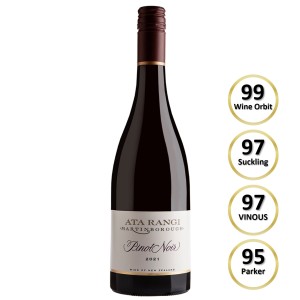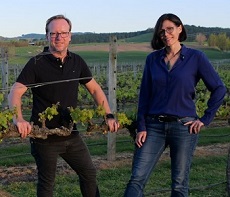
Wine from Martinborough
This small sub-region has become one of New Zealand’s most celebrated sites for producing world-class Pinot Noir and Sauvignon Blanc. The picturesque colonial village Martinborough is surrounded by small vineyards, tended by family-owned producers. With a climate and soil profile similar to that of Burgundy, it’s no wonder that Martinborough has excited the wine world. It became famous for its flagship red Pinot Noir that rivals French burgundy wines.
Ata Rangi Martinborough Pinot Noir 2021
64,90 CHF*
86,54 CHF pro Liter
One of New Zealand's wine icons. Only fruit, from the oldest parcels of vines makes up this premium Pinot Noir.
to article
Palliser Estate Martinborough Sauvignon Blanc 2024
25,90 CHF*
34,53 CHF pro Liter
An iconic Martinborough style of Sauvignon Blanc that is serious, subtle and textural while still oozing with vibrant tropical fruit characteristics.
to article
Dry River Lovat Vineyard Syrah 2019
54,90 CHF*
73,21 CHF pro Liter
One of New Zealand’s highest rated Syrah. The Lovat vineyard was planted in 1992 and thus as some of the oldest Syrah grapes in Martinborough. One of the last vintages of this outstanding wine.
to article
Ata Rangi Potiki Chardonnay 2022
39,90 CHF*
53,20 CHF pro Liter
James Suckling ranks this wine 35th among the best New Zealand wines of 2024! The wine impresses with a combination of youthful freshness, mineral precision, and remarkable complexity—qualities that make it both immediately approachable and cellar-worthy.
to article
Ata Rangi Crimson Pinot Noir 2023
36,80 CHF*
49,06 CHF pro Liter
From one of the best producers in Martinborough, in fact New Zealand. 20 years ago, Ata Rangi named this special Pinot Noir "Crimson" in support of Project Crimson. This charitable trust is working to replant and preserve native red-flowering pohutukawa and rata trees throughout New Zealand. Immediately appealing, pure, youthful with red fruit aromas, elegant spice and warm cedar.
to article
Ata Rangi Kotinga Pinot Noir 2020
69,90 CHF*
93,20 CHF pro Liter
The limited single vineyard wine from the Kotinga Vineyard. This vineyard, planted in 2001 on the edge of Martinborough Terrace, is Ata Rangi's most gravelly, free draining site. The wine is characterised by fine aromas of red fruits, plums, floral notes and an autumnal spiciness, which are wonderfully integrated by the ageing in large wooden barrels (2280l) - a wine with exceptional finesse and long ageing potential. "A beautiful wine." - James Suckling
to article
Ata Rangi Kotinga Pinot Noir 2021
69,90 CHF*
93,20 CHF pro Liter
Limited single vineyard wine from the gravelly Kotinga Vineyard (planted 2001). Fine red fruit, plum, floral, and autumnal spice aromas, elegantly aged in 2280L wooden barrels. Exceptional finesse and long ageing potential. This is the 2nd release of the Kotinga Pinot Noir.
to article
Ata Rangi Masters Pinot Noir 2021
69,90 CHF*
93,20 CHF pro Liter
The limited single-vineyard wine from the Masters vineyard of winemaker Helen Masters. Here, the alluvial gravels are mixed with clay. It retains moisture and keeps the soil cooler than in the sites around the village of Martinborough. This is the 2nd release of Masters Pinot Noir.
to article
Palliser Estate Chardonnay 2023
29,90 CHF*
39,87 CHF pro Liter
A ripe and creamy style of Chardonnay on first inspection, before the classic Palliser freshness floods the palate.
to article
Palliser Estate Pinot Noir 2023
33,00 CHF*
44,00 CHF pro Liter
Impressive Pinot Noir from one of Martinborough's outstanding producers. A savoury, structured and beautifully layered Pinot Noir, with a nose of black and red cherries, mulberry, dusky florals and star anise. The palate is juicy and expressive with lavish helpings of cherry and spice.
to article
Martinborough — world-famous boutique wines
A small village, a big reputation: family-run vineyards, Burgundian poise and some of New Zealand’s most sought-after Pinot Noir.
Martinborough is the quiet heartbeat of Wairarapa — a picturesque colonial village wrapped in vines, where small family estates coax world-class wines from soils that feel almost Burgundian in their poise and precision. Here, at the southern tip of the region, the free-draining river gravels run shallow, winds are brisk and cleansing, and the semi-maritime climate stretches the growing season long and slow.
Hot summer days, cool nights, crisp springs and autumns — a rhythm that sculpts wines of remarkable tension, fragrance and depth.

Wairarapa — "glistening waters"
Wairarapa (te reo Māori: wai rarapa, “glistening waters”) is one of New Zealand’s most compact yet captivating wine regions. It accounts for roughly 3% of the country’s vineyard area and about 1% of production — but houses an outsized roster of iconic, collectible producers.
Modern winemaking here took root in the late 1970s with pioneers such as Dry River, Martinborough Vineyard, Ata Rangi and Chifney (now Margrain), although vines were first planted in 1883. Remarkably, an 1903 Masterton wine tasted 82 years later was declared “alive and well”.
Soils & climate
Predominantly silt loam over deep, free-draining gravels deposited by wandering rivers, with pockets of clay loam and local limestone. The combination of pronounced diurnal shifts and a long, slow season — cool springs and autumns, hot summer days and cool nights — produces wines with intense varietal character, aromatic precision and fine structural tension.
What to expect from the wines
- Pinot Noir — the region’s headline act: detailed, mineral-tinged, often profound.
- Sauvignon Blanc — vivid and textural, less overtly tropical, more mineral than many other New Zealand examples.
- Chardonnay & Aromatics — stylish, finely etched whites with poise.
- Syrah — elegant, peppery and refined in the right sites.
- Late-harvest & botrytised wines — the long dry autumns create perfect conditions for noble-rot expressions.
History & character
Wairarapa’s history is a charming mix of early settler ambition and modern boutique winemaking. Small-scale, family-driven producers remain the dominant force — which is exactly why Martinborough has excited the wine world: intimacy, attention to detail and a sense that each bottle is rooted in a single vineyard's personality.
Wairarapa subregions at a glance
- Martinborough — the most southerly subregion. Shallow river terraces, free-draining soils and a cool, dry climate. Acclaimed Pinot Noir, vivid Sauvignon Blanc, poised Aromatics and elegant Syrah.
- Gladstone — south of Masterton with stony silt loams and pockets of clay. Cooler climate, lots of sunshine: excellent Pinot Noir, lively Sauvignon Blanc and impressive Aromatic varieties. Home to the annual Harvest Festival each March.
- Masterton — the valley where grapes were first planted in the region. Larger, more varied soils and marked diurnal swings; Sauvignon Blanc and Pinot Noir dominate with complexity and drive.
Visit & tourism
Martinborough is a short, scenic drive from Wellington and close to the sea on both sides — making it an ideal weekend escape. Cellar doors are intimate and often run by the families who own the vines. Pairings, boutique accommodation and a handful of exceptional restaurants make for a wine tourism experience that’s both relaxed and rewarding.




























 Germany
Germany